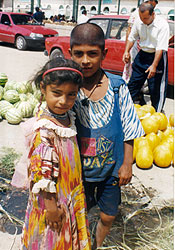The International Roma, (Gypsy) Day was founded at the first World Gypsy Congress, which took place in London on April 8, 1971. The congress gathered representatives from 30 countries. The national symbols of the gypsies – the flag and the anthem – were approved at the congress. The gypsies of the whole world became one single nation.
There are six basic branches of gypsies in the world today: three western and three eastern branches. Roma, Sinti and Iberian gypsies are referred to the Western branch. The eastern group includes the Lom, the Dom and the Lyuli people. In addition, there are smaller groups of gypsies. There are several ethnographic groups of nomadic peoples in Europe. Their lifestyle is close to that of the gypsies, but their origin is different – the Irish Travellers, or the Yeniche people from Central Europe, for instance. Many specialists, who study nomadic nations, agree that the gypsy ethnos had been finally formed only by the 15th century, when the gypsies were traveling from Byzantium to Europe.
Europeans were mistaken about the ancestral home of the gypsies for a long time. It was generally believed that the gypsies originated from Egypt. These two words – ‘gypsy’ and ‘Egyptian’ – sound alike. This is not the only myth connected with the nomadic nation. This is a positive myth for the gypsies, though: it self-identifies and unites them. The leaders of gypsy camps would often call themselves dukes and counts of Small Egypt.
Heinrich-Moritz Gottlieb Grellman, a German scientist, was the first to have set forth the idea about the Indian origin of the gypsies. The supporters of this theory refer to similarities between the gypsy language and Sanskrit. Rumor has it that elderly gypsies can understand Indian films without translation.
Nowadays, scientists believe that modern gypsies are descendants of the Dom, an Indian caste, the activities of which are identical to traditional occupations of the gypsies: smithcraft, singing and dancing. The word ‘man’ translates into the Gypsy language as ‘rom’, but the letter ‘r’ is pronounced as a guttural consonant, which sounds like ‘d’.
In India, the Doms are categorized as the lowest layer of the Indian society. In modern-day India, many of them still migrate.
Another theory says that the gypsies are the descendants of many Indian nationalities of lowest grades. It is impossible to either prove or disprove the two theories. Nomadic nations do not create material culture. The Luries, or Lyulis, are a subgroup of the Dom people living in Central Asia.
Apparently, the caste system predetermined the asociality of the socio-cultural system of the gypsies and established their lifestyle, language and traditions. Their otherness probably triggered their alienation and persecution during their movement to the West. Their traditions and language differed greatly from other peoples’ cultures.
Religion was playing a huge role in human life during the Middle Ages. It was religion that predetermined people’s attitude to their neighbors. Neither Christians, nor Muslims liked pagans. The beliefs of the gypsies did not help them during their integration in the world of Christ and Allah. Queen Mary I of England, for example, described the gypsies as a dirty race.
In 1432, the King of Hungary and Croatia, Sigismund I, relieved the gypsies of taxes owing to their role in the defense of the region. The gypsies were very good smiths – they could make fine swords, armory and cannon balls.
The Russian Roma people are one of the ethnic groups of gypsies who had been living on the territory of the Russian empire since the beginning of the 18th century. Other gypsies belong to the east-European branch of the gypsy nation. “Russian gypsies” is a broad notion, which includes all ethnic groups of gypsies in Russia.
*The post is written by – Igor Bukker
*Source: Pravda

